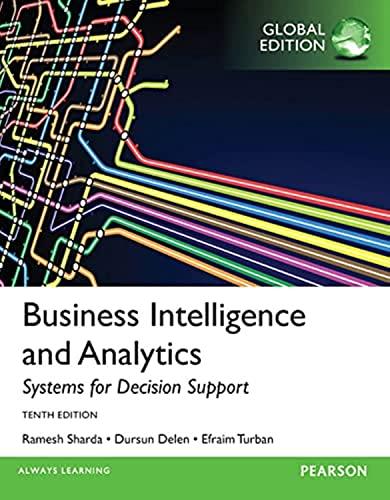Read the full Continental Airlines case (summarized in the End-of-Chapter Application Case) at teradatauniversitynetwork.com and answer the
Question:
Read the full Continental Airlines case (summarized in the End-of-Chapter Application Case) at teradatauniversitynetwork.com and answer the questions.
Continental Airlines case
As business intelligence (BI) becomes a critical component of daily operations, real-time data warehouses that provide end users with rapid updates and alerts generated from transactional systems are increasingly being deployed. Real-time data warehousing and BI, supporting its aggressive Go Forward business plan, have helped Continental Airlines alter its industry status from "worst to first" and then from "first to favorite." Continental airlines (now a part of United Airlines) is a leader in real-time DW and BI. In 2004, Continental won the Data Warehousing Institute's Best Practices and Leadership Award. Even though it has been a while since Continental Airlines deployed its hugely successful real-time DW and BI infrastructure, it is still regarded as one of the best examples and a seminal success story for real-time active data warehousing. Problem(s) Continental Airlines was founded in 1934, with a single-engine Lockheed aircraft in the Southwestern United States. As of 2006, Continental was the fifth largest airline in the United States and the seventh largest in the world. Continental had the broadest global route network of any U.S. airline, with more than 2,300 daily departures to more than 227 destinations.
Back in 1994, Continental was in deep financial trouble. It had filed for Chapter 11 bankruptcy protection twice and was heading for its third, and probably final, bankruptcy. Ticket sales were hurting because performance on factors that are important to customers was dismal, including a low percentage of on-time departures, frequent baggage arrival problems, and too many customers turned away due to overbooking.
Solution
The revival of Continental began in 1994, when Gordon Bethune became CEO and initiated the Go Forward plan, which consisted of four interrelated parts to be implemented simultaneously. Bethune targeted the need to improve customer valued performance measures by better understanding customer needs as well as customer perceptions of the value of services that were and could be offered. Financial management practices were also targeted for a significant overhaul. As early as 1998, the airline had separate databases for marketing and operations, all hosted and managed by outside vendors. Processing queries and instigating marketing programs to its high-value customers were time-consuming and ineffective. In additional, information that the workforce needed to make quick decisions was simply not available. In 1999, Continental chose to integrate its marketing, IT, revenue, and operational data sources into a single, in-house, EDW. The data warehouse provided a variety of early, major benefits. As soon as Continental returned to profitability and ranked first in the airline industry in many performance metrics, Bethune and his management team raised the bar by escalating the vision. Instead of just performing best, they wanted Continental to be their customers' favorite airline. The Go Forward plan established more actionable ways to move from first to favorite among customers. Technology became increasingly critical for supporting these new initiatives. In the early days, having access to historical, integrated information was sufficient. This produced substantial strategic value. But it became increasingly imperative for the data warehouse to provide real-time, actionable information to support enterprise wide tactical decision making and business processes.
Luckily, the warehouse team had expected and arranged for the real-time shift. From the very beginning, the team had created an architecture to handle real-time data feeds into the warehouse, extracts of data from legacy systems into the warehouse, and tactical queries to the warehouse that required almost immediate response times. In 2001, real-time data became available from the warehouse, and the amount stored grew rapidly. Continental moves real-time data (ranging from to-the-minute to hourly) about customers, reservations, check-ins, operations, and flights from its main operational systems to the warehouse. Continental's real-time applications include the following:
• Revenue management and accounting
• Customer relationship management (CRM)
• Crew operations and payroll
• Security and fraud
• Flight operations
Results
In the first year alone, after the data warehouse project was deployed, Continental identified and eliminated over $7 million in fraud and reduced costs by $41 million. With a $30 million investment in hardware and software over 6 years, Continental has reached over $500 million in increased revenues and cost savings in marketing, fraud detection, demand forecasting and tracking, and improved data center management. The single, integrated, trusted view of the business (i.e., the single version of the truth) has led to better, faster decision making. Because of its tremendous success, Continental's DW implementation has been recognized as an excellent example for real-time BI, based on its scalable and extensible architecture, practical decisions on what data are captured in real time, strong relationships with end users, a small and highly competent data warehouse staff, sensible weighing of strategic and tactical decision support requirements, understanding of the synergies between decision support and operations, and changed business processes that use real-time data.
Questions for the End-of-Chapter
Application Case
1. Describe the benefits of implementing the Continental Go Forward strategy.
2. Explain why it is important for an airline to use a realtime data warehouse.
Step by Step Answer:

Business Intelligence And Analytics Systems For Decision Support
ISBN: 9781292009209
10th Global Edition
Authors: Efraim Turban, Ramesh Sharda, Dursun Delen, Pearson Education Limited, Dennis G. Zill





